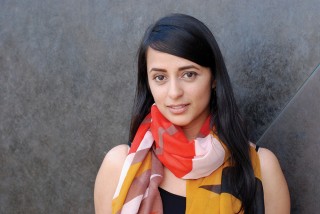Title

Reena Esmail
(Photo by Rachel Garcia)Indian-American composer Reena Esmail got her bachelor's at Juilliard and is pursuing her doctorate at Yale, so it's fitting that her alma maters should join forces to premiere her piece for choir, Baroque orchestra, sitar, and tabla called This Love Between Us: Prayers for Unity. They'll then tour it in India, where Esmail studied Hindustani vocals on a Fulbright grant. The piece was commissioned by the Yale Institute of Sacred Music for conductor David Hill, the Yale Schola Cantorum, and Juilliard415, all of whom will perform it at Alice Tully Hall on March 2, followed by a performance in New Haven the next day, and concerts in New Delhi, Mumbai, and Chennai, India after that. Robert Mealy, director of Juilliard's Historical Performance program, will be the concertmaster throughout.
Body
Esmail (BM '05, composition) spoke with Danika Paskvan, who'll play in the concerts, about what Paskvan described as a “sensitive and uplifting piece that addresses the concerns of many people at a time when peaceful interrelations across distance and culture are threatened.” Each of the work's seven movements is in English and various Indian languages or dialects; the text is drawn from the teachings of major world religions with roots in India: Buddhism, Sikhism, Islam, Jainism, Hinduism, Zoroastrianism, and Christianity.
Tell us about the title.
The title comes from the 15th-century Indian mystic saint-poet Kabir, who wrote, “This love between us cannot be annihilated,” and it encapsulates the nature of unity: love and friendship between people. The work looks at the way each religion frames that love and that friendship. I subtitled it “Prayers for Unity” because I want it to be clear that this is a religious work; prayer is a ritual that these religions have in common. I had to dig into the depths of my soul to write this piece. I come from a multireligious family, Catholic and Muslim. Because I've always been surrounded by different religious traditions, I was able to express my broad conception of religion through the piece. Also, music and religion are so related in both Western and Indian sacred traditions: Hindustani music is to Hinduism what Western classical music is to Christianity.
How about the texts?
I started out wanting to use some beautiful texts about darkness and light, but as I composed, I started to feel as if the world was falling apart around me. And I realized that I don't just want to put beauty out into the world; I also want to create real meaning. So I scrapped it all and started again, looking to the world's religions and what they say about unity, about just being good to each other. In the darkest times, sitting there with those texts side by side, it was incredibly uplifting to see these seven religions saying so clearly that we should be good to one another.
Let's talk about the piece's unique structure. How do you put together a choir, an early- music orchestra, a sitarist, and a tabla player?
Each movement calls for different kinds of dialogue between the Indian and Western musicians, which creates many unique compositional challenges. A choir and an orchestra have basically the same musical language, but Indian classical musicians are improvisers: their style of practice is very different, and they don't read music in the same way Western musicians do. Writing for that rehearsal process is a major logistical challenge.
For example, just think about the sightlines: some people are sitting on the floor, some are sitting in chairs and the conductor is standing above them all. How can you make someone feel like they are part of an ensemble if they can't even make eye contact with the other musicians? So the piece accommodates people who have very different ways of communicating. In many ways, it is a musical microcosm of what we're facing in our world right now. The musicians are trying to express themselves, but that can't happen if there isn't a process in place that allows cross-cultural communication. As the person who is engineering this environment, I love being the catalyst for really great collaboration between musicians so everyone is coming from their own place of strength.
We've talked about the connections between the players, and between you and your writing. What do you hope for the connection with the audiences in the many places your piece will be played?
In new music it often seems that our goal is to challenge the audience, to push them a little outside of their comfort zone. That's fine, but I can't help but think that there are so many people in this world who already feel very uncomfortable. The way to create a safe space where they can engage their emotions is to do the opposite: to invite them in and make them feel comfortable. Of course that's something that you can do on a human level, but you can also do it in the context of a piece of music. That's how I see myself as a composer: as someone who creates musical environments that will allow people to feel supported, to feel encouraged, and to feel that they can express themselves freely, in the language that is most natural for them. For me, something magical happens whenever someone who is not a native speaker sings my music in Hindi. Knowing that many people in the audience will understand the words sung in their languages means so much to me. I'm able to set these words of love, appreciation, and friendship in so many different languages, and we will be able to perform them for an audience who will truly understand.




